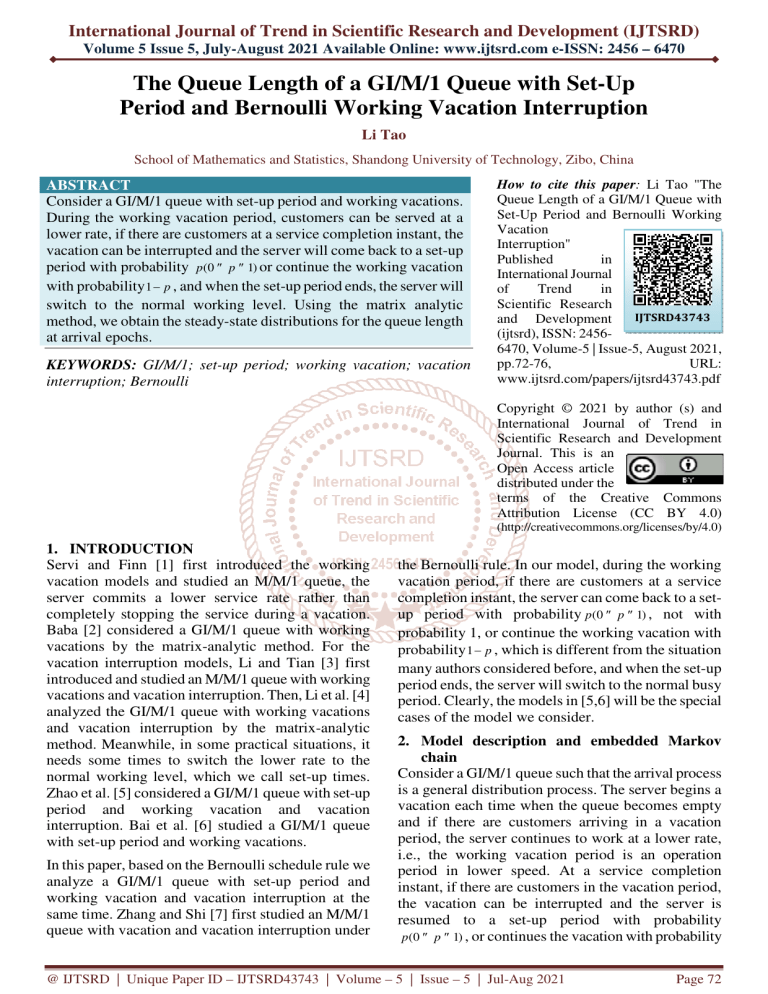
International Journal of Trend in Scientific Research and Development (IJTSRD)
Volume 5 Issue 5, July-August 2021 Available Online: www.ijtsrd.com e-ISSN: 2456 – 6470
The Queue Length of a GI/M/1 Queue with Set-Up
Period and Bernoulli Working Vacation Interruption
Li Tao
School of Mathematics and Statistics, Shandong University of Technology, Zibo, China
ABSTRACT
Consider a GI/M/1 queue with set-up period and working vacations.
During the working vacation period, customers can be served at a
lower rate, if there are customers at a service completion instant, the
vacation can be interrupted and the server will come back to a set-up
period with probability p(0 ≤ p ≤ 1) or continue the working vacation
with probability 1 − p , and when the set-up period ends, the server will
switch to the normal working level. Using the matrix analytic
method, we obtain the steady-state distributions for the queue length
at arrival epochs.
KEYWORDS: GI/M/1; set-up period; working vacation; vacation
interruption; Bernoulli
How to cite this paper: Li Tao "The
Queue Length of a GI/M/1 Queue with
Set-Up Period and Bernoulli Working
Vacation
Interruption"
Published
in
International Journal
of
Trend
in
Scientific Research
IJTSRD43743
and Development
(ijtsrd), ISSN: 24566470, Volume-5 | Issue-5, August 2021,
pp.72-76,
URL:
www.ijtsrd.com/papers/ijtsrd43743.pdf
Copyright © 2021 by author (s) and
International Journal of Trend in
Scientific Research and Development
Journal. This is an
Open Access article
distributed under the
terms of the Creative Commons
Attribution License (CC BY 4.0)
(http://creativecommons.org/licenses/by/4.0)
1. INTRODUCTION
Servi and Finn [1] first introduced the working
vacation models and studied an M/M/1 queue, the
server commits a lower service rate rather than
completely stopping the service during a vacation.
Baba [2] considered a GI/M/1 queue with working
vacations by the matrix-analytic method. For the
vacation interruption models, Li and Tian [3] first
introduced and studied an M/M/1 queue with working
vacations and vacation interruption. Then, Li et al. [4]
analyzed the GI/M/1 queue with working vacations
and vacation interruption by the matrix-analytic
method. Meanwhile, in some practical situations, it
needs some times to switch the lower rate to the
normal working level, which we call set-up times.
Zhao et al. [5] considered a GI/M/1 queue with set-up
period and working vacation and vacation
interruption. Bai et al. [6] studied a GI/M/1 queue
with set-up period and working vacations.
In this paper, based on the Bernoulli schedule rule we
analyze a GI/M/1 queue with set-up period and
working vacation and vacation interruption at the
same time. Zhang and Shi [7] first studied an M/M/1
queue with vacation and vacation interruption under
the Bernoulli rule. In our model, during the working
vacation period, if there are customers at a service
completion instant, the server can come back to a setup period with probability p(0 ≤ p ≤ 1) , not with
probability 1, or continue the working vacation with
probability 1 − p , which is different from the situation
many authors considered before, and when the set-up
period ends, the server will switch to the normal busy
period. Clearly, the models in [5,6] will be the special
cases of the model we consider.
2. Model description and embedded Markov
chain
Consider a GI/M/1 queue such that the arrival process
is a general distribution process. The server begins a
vacation each time when the queue becomes empty
and if there are customers arriving in a vacation
period, the server continues to work at a lower rate,
i.e., the working vacation period is an operation
period in lower speed. At a service completion
instant, if there are customers in the vacation period,
the vacation can be interrupted and the server is
resumed to a set-up period with probability
p(0 ≤ p ≤ 1) , or continues the vacation with probability
@ IJTSRD | Unique Paper ID – IJTSRD43743 | Volume – 5 | Issue – 5 | Jul-Aug 2021
Page 72
International Journal of Trend in Scientific Research and Development @ www.ijtsrd.com eISSN: 2456-6470
p ( p = 1 − p ),
and when the set-up period ends, the
server will switch to the normal working level.
Otherwise, the server continues the vacation.
Meanwhile, if there is no customer when a vacation
ends, the server begins another vacation, otherwise,
he switches to the set-up period, and after the set-up
period, the server switches to the normal busy period.
Suppose τ n be the arrival epoch of nth customers with
τ 0 = 0 . The inter-arrival times { τ n , n ≥ 1 } are
independent and identically distributed with a general
distribution function, denoted by A(t ) with a mean
1 / λ and a Laplace Stieltjes transform (LST), denoted
by A* ( s) . The service times during a normal service
period, the service times during a working vacation
period, the set-up times and the working vacation
times are exponentially distributed with rate µ , η ,
β and θ , respectively.
∞
t
η (η x) k −1
0
0
(k − 1)!
g k = ∫ p k −1 p ∫
e −η x e −θ x e − β (t − x ) dxdA(t ), k ≥ 1.
Using the lexicographic sequence for the states, the
transition probability matrix of ( Ln , J n ) can be written
as the Block-Jacobi matrix
B00
B1
P = B2
B3
M
A01
A1
A2
A3
M
A0
A1
A2
M
A0
A1
M
A0
M
,
O
where
B00 = 1 − c0 − d 0 − f 0 ;
c0
A0 = 0
0
A01 = (c0 , f 0 , d 0 );
f0
d0
ck
A ( β ) b0 ; Ak = 0
0
0
a0
*
fk + gk
0
0
d k + ek
bk ,
ak
k
1
−
∑ (ci + di + ei + f i + gi ) − c0 − d0 − f 0
i =1
k
*
1 − ∑ bi − A ( β )
Bk =
, k ≥ 1.
i =0
k
1 − ∑ ai
i =0
Let L(t ) be the number of customers in the system at
time t and Ln = L(τ n − 0) be the number of the customers
before the nth arrival. Define J n = 0 , the nth arrival
occurs during a working vacation period; J n = 1 , the
nth arrival occurs during a set-up period; J n = 2 , the
nth arrival occurs during a normal service period.
Then, the process {( Ln , J n ), n ≥ 1} is an embedded
Markov chain with state space
3. Steady-state distribution at arrival epochs
We
first
define
Ω = {0, 0} ∪ {(k , j ), k ≥ 1, j = 0,1, 2}.
A( z ) = ∑ ak z k , B ( z ) = ∑ bk z k , C ( z ) = ∑ ck z k ,
p(i , j ),( k ,l ) = P ( Ln +1 = k , J n +1 = ∣
l Ln = i, J n = j ).
Meanwhile, we introduce the expressions below
∞
0
bk = ∫
∞
0
( µ t )k − µt
e dA(t ), k ≥ 0,
k!
∫
t
0
β e− β x
∞
ck = ∫ p k
0
dk = ∫
0
(η x)l −η x −θ x t − β ( y − x )
e θ e ∫ βe
x
0
l!
∑p ∫
l
l =0
t
( µ (t − y )) k − l − µ ( t − y )
e
dydxdA(t ), k ≥ 0,
(k − l )!
×
ek = ∫
( µ (t − x)) k − µ (t − x )
e
dxdA(t ), k ≥ 0,
k!
(η t ) k −ηt −θ t
e e dA(t ), k ≥ 0,
k!
∞ k
∞ k
0
∑p
l −1
l =1
p∫
t
η (η x)
0
l −1
(l − 1)!
t
e−η x e −θ x ∫ β e− β ( y − x )
t
0
0
fk = ∫ p k ∫
(η x) −η x −θ x − β ( t − x )
e θe e
dxdA(t ), k ≥ 0,
k!
k
∞
∞
k =0
∞
k =0
∞
∞
k =0
k =1
D( z ) = ∑ d k z , E ( z ) = ∑ ek z , F ( z ) = ∑ f k z k , G ( z ) = ∑ g k z k .
k
k =0
k
k =1
In this section, we derive the steady-state distribution
for ( Ln , J n ) at arrival epochs using matrix-geometric
approach. In order to derive the steady-state
distribution, we need the following three lemmas.
Lemma 3.1.
A( z ) = A* ( µ − µ z ),
B( z ) =
β [ A* ( µ − µ z ) − A* ( β )]
,
β − µ (1 − z )
C ( z ) = A* (θ + η − pη z ),
D( z ) =
−
θβ
[ A* (θ + η − pη z ) − A* ( β )]
β − µ (1 − z )
θ + η − pη z − β
[ A* (θ + η − pη z ) − A* ( µ − µ z )]
θβ
,
β − µ (1 − z )
θ + pη z − ( µ − η )(1 − z )
x
( µ (t − y )) k − l − µ ( t − y )
×
e
dydxdA(t ), k ≥ 1,
(k − l )!
∞
∞
k =0
In order to express the transition matrix of ( Ln , J n ) , let
ak = ∫
∞
E ( z) =
−
pη z β [ A* (θ + η − pη z ) − A* ( β )]
β − µ (1 − z )
θ + η − pη z − β
pη z β [ A* (θ + η − pη z ) − A* ( µ − µ z )]
,
β − µ (1 − z )
θ + pη z − ( µ − η )(1 − z )
@ IJTSRD | Unique Paper ID – IJTSRD43743 | Volume – 5 | Issue – 5 | Jul-Aug 2021
Page 73
International Journal of Trend in Scientific Research and Development @ www.ijtsrd.com eISSN: 2456-6470
F ( z) =
G( z) =
θ [ A* ( β ) − A* (θ + η − pη z )]
,
θ + η − pη z − β
where
σ=
pη z[ A* ( β ) − A* (θ + η − pη z )]
.
θ + η − pη z − β
Lemma 3.3. If θ > 0 , β > 0 and ρ = λ / µ < 1 , then the
matrix
equation R = ∑ R k Ak has
the
minimal
k =0
nonnegative solution
π 00 + (π 10 , π 11 , π 12 )( I − R )−1 e = 1,
where e is a column vector with all elements equal to
one. Substituting R into the above relationship, we
can get
(1 − r1 )(1 − r2 )(1 − r3 )
= (1 − r3 )σ .
(1 − r3 )[(1 − r2 ) + δ (r2 − r1 )] + ∆δ (1 − r1 )(r3 − r2 ) − γδ (1 − r2 )(r3 − r1 )
Therefore, we have
(π 10 , π 11 , π 12 ) = (1 − r3 )σ (r1 , δ (r2 − r1 ), ∆δ (r3 − r2 ) − γδ (r3 − r1 )) .
where r2 = A* ( β ) , r1 and r3 are the unique roots in the
range
0<z<1
of
equations
*
*
z = A (θ + η − pη z ) and z = A ( µ − µ z ) , respectively, and
δ = (θ + pη r1 ) / (θ + η − pη r1 − β ) ,
∆ = β / [ β − µ (1 − r2 )] ,
γ = β / [θ + pη r1 − ( µ − η )(1 − r1 )] .
Moreover, we can easily verify that the Markov
chain P is positive recurrent if and only if
θ > 0 , β > 0 and ρ < 1 . And the matrix
with ω = [
With
(π 00 , π 10 , π 11 , π 12 ) is
K=
r1 δ (r2 − r1 ) ∆δ (r3 − r2 ) − γδ (r3 − r1 )
R =0
r2
∆(r3 − r2 )
,
0
0
r3
B00
A01
∞
B[ R ] = ∞ k −1
k −1
∑ R Bk ∑ R Ak
k =1
k =1
1 − c0 − d 0 − f 0
c0
c0 + f 0 − δ ( r2 − r1 ) − ω 1 − c0
r1
r1
r1
=
a0 ∆ ( r3 − r2 ) b0
+
1−
0
r2 r3
r2
a0
0
r3
the Theorem 1.5.1 in [8],
given by the positive left invariant
vector Eq. (1), and satisfies the normalizing condition
Proof.
θ >0,
the
Lemma
3.2.
If
equation z = A* (θ + η − pη z ) has a unique root in the
range 0<z<1.
∞
(1 − r1 )(1 − r2 )
.
(1 − r3 )[(1 − r2 ) + δ ( r2 − r1 )] + ∆δ (1 − r1 )(r3 − r2 ) − γδ (1 − r2 )( r3 − r1 )
Using the Theorem 1.5.1 of Neuts [8], we can obtain
π k = (π k 0 , π k1 , π k 2 ) = (π 10 , π 11 , π 12 ) R k −1 , k ≥ 1. (2)
Taking (π 10 , π 11 , π 12 ) and R k −1 into Eq. (2), the theorem
can be derived.
Then, we discuss the distribution of the queue length
L at the arrival epochs. From Theorem 3.4, we have
π 0 = P{L = 0} = π 00 = (1 − r3 )σ ,
π k = P{L = k} = π k 0 + π k1 + π k 2
= (1 − r3 )σ [(1 − δ )r1k + δ r2k + ∆δ (r3k − r2k ) − γδ (r3k − r1k )], k ≥ 1.
f0
δ ( r2 − r1 ) f 0
−
r1
r1
0
0
ω
a0 ∆ ( r3 − r2 ) b0
−
r2 r3
r2
a
1− 0
r3
d0
∆δ (r3 − r2 ) γδ (r3 − r1 )
d
δ (r2 − r1 )
−
]a0 +
b0 − 0
r2 r3
r1r3
r1r2
r1
has a
positive left invariant vector
The state probability of a server in the steady-state is
given by
∞
P{J = 0} = ∑ π k 0 =
k =0
(1 − r3 )σ
,
1 − r1
∞
σδ (1 − r3 )(r2 − r1 )
k =1
(1 − r1 )(1 − r2 )
P{J = 1} = ∑ π k 1 =
,
∞
σ∆δ (1 − r1 )(r3 − r2 ) − σγδ (1 − r2 )(r3 − r1 )
k =1
(1 − r1 )(1 − r2 )
P{J = 2} = ∑ π k 2 =
.
π 0 = π 00 ; π k = (π k 0 , π k1 , π k 2 ), k ≥ 1,
Theorem 3.5. If θ > 0 , β > 0 and ρ < 1 , the stationary
queue length L can be decomposed as L = L0 + Ld ,
where L0 is the stationary queue length of a classical
GI/M/1 queue without vacation, and follows a
geometric distribution with parameter r3 . Additional
queue length Ld has a distribution
π kj = P{L = k , J = j} = lim P{Ln = k , J n = j}, (k , j ) ∈ Ω.
P{Ld = 0} = σ ,
Theorem 3.4. If θ > 0 , β > 0 and ρ < 1 , the stationary
probability distribution of ( L, J ) is given by
P{Ld = k} = σ (δ − 1 − γδ )(r3 − r1 )r1k −1
π k 0 = (1 − r3 )σ r1k , k ≥ 0,
k
k
π k 1 = (1 − r3 )σδ (r2 − r1 ), k ≥ 0,
π = (1 − r )σ [∆δ (r k − r k ) − γδ (r k − r k )], k ≥ 1,
3
3
2
3
1
k2
Proof. The probability generating function of L is as
follows:
K (1, r1 , δ (r2 − r1 ), ∆δ (r3 − r2 ) − γδ (r3 − r1 )) (1)
where K ia a random positive real number.
Let ( L, J ) be the stationary limit of the process ( Ln , J n ) ,
and denote
n →∞
+σδ (∆ − 1)(r3 − r2 ) r2k −1 ,
@ IJTSRD | Unique Paper ID – IJTSRD43743 | Volume – 5 | Issue – 5 | Jul-Aug 2021
k ≥ 1.
Page 74
International Journal of Trend in Scientific Research and Development @ www.ijtsrd.com eISSN: 2456-6470
∞
∞
∞
k =0
k =1
k =1
∞
L( z ) = ∑ π k 0 z k + ∑ π k1 z k + ∑ π k 2 z k
1 − r3 1 − r3 z
( r − r )(1 − r3 z ) z
(r − r ) z
(r − r ) z
σ[
+δ 2 1
+ ∆δ 3 2 − γδ 3 1 ]
1 − r3 z 1 − r1 z
(1 − r1 z )(1 − r2 z )
1 − r2 z
1 − r1 z
1− r3
(r − r )z
(r − r )z (r − r )z
(r − r )z
(r − r )z
=
σ[1− 3 1 + δ 3 1 −δ 3 2 +∆δ 3 2 − γδ 3 1 ]
1− r3 z
1− r1z
1− r1z
1− r2 z
1− r2 z
1− r1z
1 − r3
(r − r ) z
(r − r ) z
=
[σ + σ (δ − 1 − γδ ) 3 1 + σδ (∆ − 1) 3 2 ]
1 − r3 z
1 − r1 z
1 − r2 z
i =k
Thus, the mean queue length at the arrival epoch is
given by
r3
σ (δ − 1 − γδ )(r3 − r1 ) σδ (∆ − 1)(r3 − r2 )
+
+
.
1 − r3
(1 − r1 ) 2
(1 − r2 ) 2
4. Steady-state distribution at arbitrary epochs
Now we consider the steady-state distribution for the
queue length at arbitrary epochs. And, denote the
limiting distribution of L(t ) : pk = lim
P{L(t ) = k} .
t →∞
Theorem 4.1. If θ > 0 , β > 0 and ρ < 1 , the limiting
distribution of L(t ) exists. And, we obtain
∆δ − γδ (1 − ∆)δ (1 − r3 ) (1 − δ + γδ )(1 − r3 )
+
+
],
p0 = 1 − σλ[ µ
β
θ + η − pη r1
∆δ − γδ k −1 (1 − ∆)δ (1 − r2 ) k −1 (1 − δ + γδ )(1 − r1 ) k −1
pk = (1 − r3 )σλ[
r3 +
r2 +
r1 ], k ≥ 1.
µ
β
θ + η − pη r1
Proof. From the theory of SMP, the limiting
distribution of L(t ) has the following expression (see
[9]):
pk =
∞
∑π ∫
∞
+ ∑ π i1 ∫
∞
∫
0
i = k −1
∞
i2 0
i = k −1
t
( µ t )i +1− k − µt
e λ (1 − A(t ))dt
(i + 1 − k )!
β e− β x
0
t
η (η x)i − k
0
0
(i − k )!
( µ (t − x))i +1− k − µ (t − x )
e
dxλ (1 − A(t ))dt
(i + 1 − k )!
We compute each part of the equation and have
b1 = (1 − r3 )σλ[
+π k −1,1 ∫ e
−βt
0
∞
∞
0
i = k −1
+
∞
∞ i + 1− k
∑π ∫ ∑
i = k −1
i0
−
0
l =0
(η x ) l −η x −θ x t − β ( y − x )
e θ e ∫ βe
0
x
l!
t
( µ (t − y )) i +1− k − l − µ ( t − y )
×
e
dydx λ (1 − A(t )) dt
(i + 1 − k − l )!
∞
+∑ π i 0 ∫
∞ i +1− k
0
i =k
×
∑
l =1
t
η (η x)l −1
0
(l − 1)!
p l −1 p ∫
t
e−η x e −θ x ∫ β e − β ( y − x )
x
( µ (t − y ))
e − µ ( t − y ) dydxλ (1 − A(t ))dt
(i + 1 − k − l )!
i +1− k − l
1 − A ( µ − µ r1 ) k −1
r1 ],
µ (1 − r1 )
b3 = (1 − r3 )σλ[
b4 = (1 − r3 )σλ
b5 = (1 − r3 )σ
−
b6 =
1 − A* ( µ − µ r2 ) k −1
1 − r2 k −1
r2 − ∆δ
r2
µ (1 − r2 )
β
δ (1 − r2 ) k −1 δ (1 − r2 ) k −1
r2 −
r1 ],
β
β
1 − r1
r1k −1 ,
θ + η − pη r1
(1 − r3 )σλ
θβ r1k −1
1 − r1
1 − r2
(
−
)
β − µ + µ r1 θ + η − pη r1 − β θ + η − pη r1
β
(1 − r3 )σλθγ r1k −1
1 − r1
1 − A* ( µ − µ r1 )
−
[
],
β − µ + µ r1 θ + η − pη r1
µ (1 − r1 )
(1 − r3 )σλ
pηβ r1k
1 − r1
1 − r2
(
−
)
β − µ + µ r1 θ + η − pη r1 − β θ + η − pη r1
β
−
b7 =
1 − A* ( µ − µ r2 ) k −1
r2
µ (1 − r2 )
(1 − A* ( µ − µ r1 )) k −1
δ (1 − r2 ) k −1
βδ
r1 +
r1 ],
β − µ + µ r1
µ (1 − r1 )
β − µ + µ r1
(1 − r3 )σλ pηγ r1k
1 − r1
1 − A* ( µ − µ r1 )
[
−
],
β − µ + µ r1 θ + η − pη r1
µ (1 − r1 )
(1 − r3 )σλθ r1k −1 1 − r2
1 − r1
(
−
),
θ + η − pη r1 − β β
θ + η − pη r1
Then, using these expressions, the theorem can be
obtained by some computation.
Let L denote the steady-state system size at an
arbitrary epoch, the mean of L can be given by
k =0
(η t )i +1− k −η t −θ t
e e λ (1 − A(t ))dt
(i + 1 − k )!
pl ∫
µ
r3k −1 − ∆δ
*
E[ L] = ∑ k pk = (1 − r3 )σλ[
λ (1 − A(t ))dt
+ ∑ π i 0 ∫ p i +1− k
∆δ − γδ
b2 = (1 − r3 )σλ[∆δ
∞
∞
e −η x e −θ x e − β (t − x ) dxλ (1 − A(t ))dt
= b1 + b 2 + b3 + b 4 + b5 + b6 + b7 + b8.
+ γδ
which completes the proof.
t
∞
∞
+∑ π i 0 ∫ pi −k p ∫
= L0 ( z ) Ld ( z ).
E[ L ] =
0
i = k −1
(r3 − r2 )z
(r3 − r1 )z
(r2 − r1)z
1
= (1− r3 )σ[
+δ
+∆δ
−γδ
]
1− r1z (1− r1z)(1− r2 z)
(1− r2 z)(1− r3 z)
(1− r1z)(1− r3 z)
=
(η x)i +1− k −η x −θ x − β (t − x )
e θe e
dxλ (1 − A(t ))dt
0 (i + 1 − k )!
∞
+ ∑ π i 0 ∫ p i +1− k ∫
∆δ − γδ
(1 − ∆ )δ
1 − δ + γδ
+
+
].
µ (1 − r3 )2 β (1 − r2 ) (1 − r1 )(θ + η − pη r1 )
Remark 4.2. If p = 1 , the system reduces to the model
described in [4], and if p = 0 , the system becomes a
GI/M/1 queue with set-up period and multiple
working vacations [6].
References
[1] L. Servi and S. Finn, “M/M/1 queue with
working
vacations
(M/M/1/WV)’’,
Performance Evaluation, vol. 50, pp. 41-52,
2002.
[2]
Y. Baba, “Analysis of a GI/M/1 queue with
multiple working vacations’’, Operations
Research Letters, vol. 33, pp. 201-209, 2005.
@ IJTSRD | Unique Paper ID – IJTSRD43743 | Volume – 5 | Issue – 5 | Jul-Aug 2021
Page 75
International Journal of Trend in Scientific Research and Development @ www.ijtsrd.com eISSN: 2456-6470
[3]
J. Li and N. Tian, “The M/M/1 queue with
working vacations and vacation interruption’’,
Journal of Systems Science and Systems
Engineering, vol. 16, pp. 121-127, 2007.
[6]
X. Bai, X. Wang, and N. Tian, “GI/M/1 queue
with set-up period and working vacations’’,
Journal of Information and Computational
Science, vol. 9, pp. 2313-2325, 2012.
[4]
J. Li, N. Tian, and Z. Ma, “Performance
analysis of GI/M/1 queue with working
vacations and vacation interruption’’, Applied
Mathematical Modelling, vol. 32, pp. 27152730, 2008.
[7]
H. Zhang and D. Shi, “The M/M/1 queue with
Bernoulli-schedule-controlled vacation and
vacation interruption’’, International Journal of
Information and Management Sciences, vol. 20,
pp. 579-587, 2009.
[5]
G. Zhao, X. Du, and N. Tian, “GI/M/1 queue
with set-up period and working vacation and
vacation interruption’’, International Journal of
Information and Management Sciences, vol. 20,
pp. 351-363, 2009.
[8]
M. Neuts, “Matrix-Geometric Solutions in
Stochastic Models’’, Johns Hopkins University
Press, Baltimore, 1981.
[9]
D. Gross, C. Harris, “Fundamentals of
Queueing Theory’’, 3rd Edition, Wiley, New
York, 1998.
@ IJTSRD | Unique Paper ID – IJTSRD43743 | Volume – 5 | Issue – 5 | Jul-Aug 2021
Page 76





